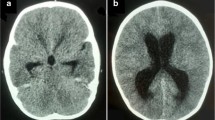Abstract
Introduction
Choroid plexus cysts can lead to isolation of the lateral ventricles and distension of the third ventricle. We present an ultrasonographic video documentation of an infant with variably shaped and localized choroid plexus cyst of the third ventricle.
Case report
An infant had periods of increased intracranial pressure with changing dilatation of the first to third ventricle. Cerebral ultrasonography of the not crying boy demonstrated a choroid plexus cyst limply hanging down from the roof of the third ventricle to the beginning of the aqueduct of Sylvius. During crying, the cyst prolapsed from the third into left lateral ventricle and was strangled by the foramen of Monro. Endoscopic cyst fenestration and third ventriculostomy continuously solved the problem of intermittent hydrocephalus occlusus.
Conclusion
Depending not only on localization and size but also on cyst form and cerebrospinal fluid pressure, a single choroid plexus cyst can cause various obstructions of cerebrospinal fluid pathways.
Similar content being viewed by others
Avoid common mistakes on your manuscript.
Introduction
A choroid plexus cyst of the left lateral ventricle can obstruct the foramen of Monro and can prolapse through the foramen of Monro into the third ventricle [2]. Choroid plexus cysts of the third ventricle can prolapse through the foramen of Monro into the lateral ventricles as well [1, 4]. Increasing choroid plexus cysts can lead to isolation of the lateral ventricles and distension of the third ventricle, suggestive of hydrocephalus secondary to cerebral aqueduct obstruction. We present an ultrasonographic video documentation of an infant with a flexible and floating choroid plexus cyst of the third ventricle intermittently obstructing the foramen of Monro and aqueduct of Sylvius.
Case report
In the second as well as in the fourth month of life, a boy had a short period of increased intracranial pressure with changing dilatation of the first to third ventricle. The sagittal ultrasonographic section demonstrated a choroid plexus cyst prolapsing from the third ventricle into the dilated left lateral ventricle and strangled by the foramen of Monro during crying of the 4-month-old infant (Fig. 1 and Video). A previous ultrasonogram of the not crying infant showed the cyst hanging full (Fig. 2a), as well as limply (Fig. 2b), from the roof of the third ventricle to the beginning of the aqueduct of Sylvius. At age of 6 months, a third period of acute somnolence and cardiac tachyarrhythmia appeared. Magnetic resonance imaging (MRI) revealed an asymmetrical enlargement of the lateral ventricles due to the bulging cyst in the third ventricle (Fig. 3). Emergency endoscopic coagulation of the rough and vessel-rich membrane of a choroid plexus cyst, which filled the dorsal portion of the third ventricle, and third ventriculostomy continuously solved the problem of intermittent blockage of cerebrospinal fluid (CSF) pathways (Fig. 4).
Discussion
The mobility of choroid plexus cysts depends on the location, size, and CSF pressure, e.g. during crying. The form and size of choroid plexus cysts can vary because of varying CSF secretion by the cyst epithelium into the cyst [3]. Full choroid plexus cysts lead to triventricular internal hydrocephalus feigning an obstruction of the aqueduct of Sylvius [1, 2, 4]. In contrast, the limp choroid plexus cyst of our patient apparently obstructed the cerebral aqueduct with components of the cyst wall, explaining the intermittent dilatation of the third ventricle. Therefore, not only full and large but also flexible and floating choroid plexus cysts seem to cause CSF blockage. In such cases, the real-time ultrasound technology seems to be helpful in monitoring conditions of cyst and drainage.
References
Lam AH, Villanueva AC (1992) Symptomatic third ventricular choroid plexus cysts. Pediatr Radiol 22:413–416
Parizek J, Jakubec J, Hobza V, Nemeckova J, Cernoh Z, Sercl M, Zizka J, Spacek J, Nemecek S, Suba P (1998) Choroid plexus cyst of the lateral ventricle with intermittent blockage of the foramen of Monro, and initial invagination into the III ventricle in a child. Child’s Nerv Syst 14:700–708
van Baalen A, Versmold H (2004) Choroid plexus cyst: comparison of new ultrasound technique with old histological finding. Arch Dis Child 89:426
Vlaho S, Gebhardt B, Gerlach R, Weidauer S, Kieslich M (2003) Cyst of the third ventricle as an unusual cause of acquired hydrocephalus. Pediatr Neurol 28:225–227
Acknowledgements
We thank Martin Möllers (Department of Pediatrics) and Gerd Steffen (Department of Neurosurgery), senior doctors of the Protestant Hospital Bielefeldt (Germany), for their very kind cooperation and helpful support.
Author information
Authors and Affiliations
Corresponding author
Rights and permissions
About this article
Cite this article
van Baalen, A., Stephani, U. Flexible and floating choroid plexus cyst of the third ventricle: an ultrasonographic video documentation. Childs Nerv Syst 23, 259–261 (2007). https://doi.org/10.1007/s00381-006-0254-9
Received:
Revised:
Published:
Issue Date:
DOI: https://doi.org/10.1007/s00381-006-0254-9








